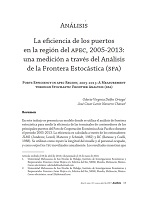Ports Efficiency in APEC Region, 2005-2013: A Measurement through Stochastic Frontier Analysis (SFA)
DOI:
https://doi.org/10.32870/mycp.v6i16.519Keywords:
Stochastic Frontier Analysis, Efficiency, Ports, APECAbstract
This paper presents a model using the Stochastic Frontier Analysis to measure the efficiency of container terminals in the main ports of Asia-Pacific Economic Cooperation for the period 2005-2013. Efficiency is calculated through the estimators: JLMS (Jondrow, Lovell, Materov & Schmidt, 1982) and BC (Batesse & Coelli, 1988). It was used as inputs quay length and employed personnel and for output teus annually moved. The scores showed that in the period analyzed, any port was efficient on average, while Shanghai was the one who presented the highest results, in contrast to the port of Callao in Peru, whose efficiency levels were the lowest.Downloads
References
Afriat, S. N. (1972). “Efficiency estimation of production functions”, International Economic Review, 13(3): 568-598.
Aguilar, R. (2005). “La participación de México en la Cuenca del Pacífico”, De Jure, año 5, segunda época, núm. 2, pp. 155-174
Aigner, D. J. y Chu, S. F. (1968). “On estimating the industry production function”, American Economic Review, 52 (4): 762-782.
Aigner, D. J., Lovell, C. A. y Schmidt, P. (1977). “Formulation and estimation of stochastic frontier production models”, Journal of Econometrics, 6(1): 21-37.
Apec. (2015). Países miembros del apec . Recuperado de http://www.apec.org/about-us/about-apec/member-economies.aspx [10/11/2015].
Apec. (2016). Statistics apec, Key Indicators Database. Recuperado de: http://statistics.apec.org/index.php/apec_psu/index
Batesse, G. E. y Coelli, T. J. (1988). “Prediction of Firm Level Technical Efficiencies with a Generalized Frontier Production Function and Panel Data”, Journal of Econometrics, núm. 38, pp. 387-399.
Batesse, G. E. y Coelli, T. J. (1992). “Frontier Production Functions, Technical efficiency and Panel Data: With Application to Paddy Farmers in India”, The Journal of Productivity Analysis, núm. 3, pp. 153-169.
Bruin, J. (2006). New test: Command to compute new test. Los Ángeles: ucla Statistical Consulting Group. Recuperado de: http://www.ats.ucla.edu/stat/stata/ado/analysis/ [21/10/2015].
Coelli, T. J., Prasada, D., O’Donnell, C., y Battese, G. E. (2005). An Introduction to Efficiency and Productivity Analysis, 2a edición. Estados Unidos: Springer.
Cullinane, K., y Song, D. (2006). “Estimating the Relative Efficiency of European Container Ports: A Stochastic Frontier Analysis”, Research in Transportation Economics, núm. 16, pp. 85-115.
Debreu, G. (1951). “The Coefficient of Resource Utilization”, Econometrica, 19(3): 273-292.
Farrell, M. (1957). “The Measurement of Productive Efficiency”, Journal of the Royal Statistical Society, serie A, 120, parte III, pp. 253-267.
Fergusson, I. F., McMinim, M. A., y Williams, B. L. (2015). The Trans-Pacific Partnership (tpp) Negotiations and Issues for Congress. Washington, dc: Congressional Research Service.
González G. J. (2002). “México y el apec 2002. Recapitulación y perspectivas”, Comercio Exterior, 52(9): 777-788.
Greene, W. H. (1990). “A Gamma-distributed stochastic frontier model”, Journal of Econometrics, 46(1-2): 141-163. Elsevier.
Greene, W. H. (1999). “Frontier production functions”, en: Pesarsan, M. H. y P. Schmidt (eds.), Handbook of Applied Econometric, vol. II, Microeconomics, pp. 81-164.
Greene, W. H. (2003). “Maximum simulated likelihood estimation of the normal-gamma stochastic frontier function”, Journal of Productivity Analysis, núm. 19, pp. 179-190.
Guangqi, S., y Shiping, Z. (2000). “The apec future maritime policy and its evaluation”, Maritime Policy & Management, 27(2): 209-213.
Gujarati, D., y Porter, D. (2010). Econometría, 5a edición. México, df: McGraw-Hill.
Hausman, J. (1978). “Specification Test”, Econometrics, núm. 46, pp. 1251-1271.
Johansen, S. (1988). “Statistical Analysis of Cointegration Vectors”, Journal of Economic Dynamics and Control, 12(2–3): 231-254.
Johansen, S. (1991). “Estimation and Hypothesis Testing of Cointegration Vectors in Gaussian Vector Autoregressive Models”, Econometrica, 59(6): 1551-1580.
Jondrow, J., Lovell, K., Materov, I., y Schmidt, P. (1982). “On the estimation of technical inefficiency in the stochastic frontier production function model”. Journal of Econometrics, núm. 19, pp. 233-238.
Koopmans, T. (1951). “Efficient Allocation of Resources”, Econometrica, 19(4): 455-465.
Levin, A., Lin, C. F., y Chu, C. S. J. (2002). “Unit root tests in panel data: Asymptotic and finite-sample properties”, Journal of Econometrics, núm. 108, pp. 1-24.
Meeusen, W., y Van den Broeck, J. (1977). “Efficiency estimation from Cobb–Douglas production functions with composed error”, International Economic Review, 18(2): 435-444.
Merk, O., y Dang, T. (2012). “Efficiency of world ports in container and bulk cargo (oil, coal, ores and grain)”, oecd Regional Development Working Papers, 2012/09. Oecd Publishing. Disponible en: http://dx.doi.org/10.1787/5k92vgw39zs2-en [12/09/2015].
Montero, R. (2013). Variables no estacionarias y cointegración. Documentos de Trabajo en Economía Aplicada. España: Universidad de Granada.
Morales, J., Araya, G., Serebrisky, T., Briseño-Garmendia, A., y Schwartz, J. (2013). Benchmarking Container Port Technical Efficiency in Latin America and Caribbean: A Stochastic Frontier Analysis. Policy Research Working Paper 6680. The World Bank-Latin American and Caribbean Region-Sustainable Development Department.
Otieno, R., Khin, L., Hualong, Y., y Banomyong, R. (2011). “Sea-Port Operational Efficiency: An Evaluation of Five Asian Ports Using Stochastic Frontier Production Function Model”, Journal of Service Science and Management, núm. 4, pp. 391-399.
Palacios, L. J., González, G. J., y Rangel, D. E. (2006). Las relaciones económicas México-Asia Pacífico en los albores del siglo xxi: Análisis de su dinámica e implicaciones de política. Colima, Colima, México: Universidad de Colima-Facultad de Economía.
Petri, P., y Plummer, M. (2012). The Trans-Pacific Partnership and Asia-Pacific Integration: Policy Implications. Peterson Institute for International Economics Policy Brief, Forthcoming. Disponible en: http://ssrn.com/abstract=2108399
Ragnar, Frisch. (1934). Statistical Confluence Analysis by Means of Complete Regression Systems. Oslo, Noruega: Oslo University-Institute of Economics, publ. núm. 5.
Ramsey, J. (1969). “Test for Specification Errors in Classical Linear Least Square Regression Analysis”, Journal of the Royal Statistical Society, Series B, 31(2): 350-371.
Richmond, J. (1974). “Estimating the Efficiency of Production”, International Economic Review, núm. 15, pp. 515-521.
Rodríguez, E. (2015). “Algunos aspectos del desarrollo económico de Japón y los tigres asiáticos”, Observatorio Iberoamericano de la Economía y de la Sociedad en Japón, 7(22). Recuperado de: http://www.eumed.net/rev/japon/22/desarrollo.pdf [11/01/2016].
Rodríguez, I. (2014). “Nuevas configuraciones económicas en el Asia-Pacífico y sus consecuencias para América Latina: Desde el apec a la Alianza del Pacífico”, Dados - Revista de Ciências Sociais, abril-junio, pp. 553-580.
SE (2012). “Foro de Cooperación Económica Asia-Pacífico (apec). Dirección General de Negociaciones Multilaterales y Regionales”, Memorias Documentales. Recuperado de: http://www.economia.gob.mx/files/transparencia/informe_APF/memorias/12_md_apec_sce.pdf [15/10/2015].
Seitz, W. D. (1971). “Productive Efficiency in the Steam-Electric Generating Industry”, Journal of Political Economy, núm. 79, pp. 878-886.
Shephard, R. (1953). Theory Cost and Production Functions. Nueva Jersey, Estados Unidos: Princeton University Press.
Stata. (2014). Stata Data Analysis and Statistical Software. Recuperado de http://www.stata.com/ [15/06/2015].
Stevenson, R. (1980). “Likelihood functions for generalized stochastic frontier estimation”, Journal of Econometrics, núm. 13, pp. 57-66.
Timmer, C. P. (1971). “Using a Probabilistic Frontier Production Function to Measure Technical Efficiency”, Journal of Political Economy, núm. 79, pp. 776-794.
Traslosheros, G. (2003). “Principales actividades y resultados del apec México 2002”, Informe del presidente de la Reunión de Funcionarios de Alto Nivel de apec México 2002. Secretaría de Economía. Disponible en http://www.protlcuem.gob.mx/swb/work/models/economia/Resource/428/1/images/act02_esp.pdf [22/06/2016].
Waldman, D. (1982). “A Stationary Point for Stochastic Frontier Likelihood”, Journal of Econometrics, núm. 18, pp. 275-279.
World Shipping Council. (2014). Top 50 World Container Ports. Recuperado de: http://www.worldshipping.org/about-the-industry/global-trade/top-50-world-container-ports [10/03/2015]

Downloads
Published
How to Cite
Issue
Section
License
Open Access Policy
This journal provides open access to all its contents, in adherence to the principle that making research freely available supports a greater global exchange of knowledge.
MyCP is licensed under a Creative Commons Attribution-NonCommercial license, also known as CC BY-NC.
Contents are published in both PDF and XML formats.
Authors who publish in México y la Cuenca del Pacífico must accept the following conditions:
Pursuant to Mexican copyright laws, México y la Cuenca del Pacífico acknowledges and respects the authors’ moral right and ownership of property rights, which will be assigned to the University of Guadalajara to publish the articles in an open-access mode.
México y la Cuenca del Pacífico does not charge the authors any fees for receiving and processing their articles.
Authors are permitted to enter into other independent and additional contractual agreements for the non-exclusive distribution of the article version published in México y la Cuenca del Pacífico (for example, publishing it in an institutional repository or in other printed or electronic media) as long as they clearly state that the piece was originally published in México y la Cuenca del Pacífico.
Pursuant to the above, once the article is approved for publication, authors must send the Assignment of Rights Agreement form duly filled and signed. This form must be sent to mexicoylacuenca@gmail.com as a PDF file.
Readers/users of México y la Cuenca del Pacífico can freely access the journal new issues as soon as they are uploaded. Readers/users are allowed to cite, share (both electronically and physically), print and distribute the material, provided they expressly state that the work was originally published in México y la Cuenca del Pacífico. Contents are to be properly cited and never for commercial purposes.




